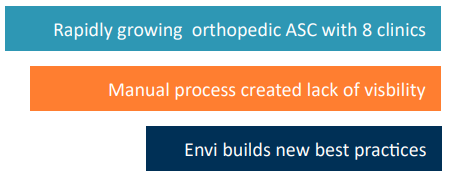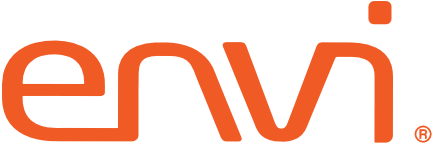
Specialty Orthopedic Group (SOG) is a single-specialty ASC in northern Mississippi, quickly expanding with satellite clinics throughout the area. The Tupelo facility is the only privately-owned orthopedic ASC in the region, delivering a wide range of orthopedic surgeries. The organization continually recruits new surgeons in multiple orthopedic subspecialties, representing significant growth opportunities.
THE SPECIALTY ORTHOPEDIC GROUP STORY
Overcoming the Manual Process Challenge
Specialty Orthopedic Group (SOG) launched in 2015 to deliver a wide range of orthopedic surgical procedures to local residents. When Loren Anderson, Manager, Supply Chain Operations came on board, he found a new surgery center experiencing rapid growth, yet supported by manual processes and no supply chain management systems in place.
Anderson was an experienced user of the Envi® materials management solution, and saw the opportunity to create better processes with technology. “I started in a consulting role, working with the clinical team to identify what they needed, what was in use, and basic information like how often items were used. We took a first step by re-organizing the shelves in the very busy OR supply room.” When Anderson onboarded as a full time employee, he began looking at ways to apply proven supply chain processes. “I knew I needed to get new systems in place. Supplies were running out every day; we didn’t have good visibility to use.”
Implementing the Envi Solution
Once they selected Envi, Anderson quickly got implementation underway, beginning with the ASC, then onboarding the clinics.
“At the beginning, we just needed a purchase order system. We’re a busy surgery center and have a lot of supplies and POs to manage. We didn’t have good visibility into what was ordered and due, so it was hard to manage supplies well. Having used Envi previously, I knew how to set up our supply locations and processes, and train our end users to take advantage of the system capabilities.”
Anderson added, “At the beginning, with no PO history, I worked with a scrub tech who knows every item really well and could tell me exactly what we pull for each doctor’s case, how many cases they did each week. We literally walked through the store room and reviewed every item.” This important step enabled minimum/maximum inventory levels for each product. “We had to set levels and not always easy to get an initial number. We can refine, but having that min/max gives me a starting point to know what I’m going to order. I want our store rooms so well set that I don’t even have to know a center’s details to know that ordering is running smoothly.”
New Best Practices Across the Organization
Envi gave Anderson the tools to begin, and the team started with fundamentals, like moving from paper to
EDI POs and invoices, creating PO approval processes, back order management, and reorganizing the physical inventory. “We did a reset on expectations as new processes came online,” said Anderson. “For example – our materials manager prints a weekly PO backorder list and tracks what needs follow-up. We proactively ensure we’re not running out of supplies and know exactly what’s received. That’s helped build confidence with our clinical team.”
Another significant area of improvement has been with Accounts Payable. “Weekly invoices from our primary vendors can number in the hundreds. EDI invoices save hours of scanning and entering, which was ridiculously labor-intensive. Electronic invoices enable a quick match, saving hours and hours each week.” Anderson proactively helps the AP team by identifying past due invoices. “I run a pending invoice report to see what’s open or missing and what we should expect. This helps with cash flow and avoids surprises.”

But one of the most important results is creating systemwide visibility. Today it’s easy to see orders in process, from the ASC through the clinics. “We have great insight to where and how spend occurs. We can see an overall picture of medical supplies as a percent of revenue, even to the specific item level.”
If a new product is selected, Anderson and his team perform calculations to show what’s being spent currently, and whether savings can occur. “We can go to our board and present a solid case on supply spend, and the board can make recommendations around improvements in our clinical processes.”
Anderson now targets accurate case costing. “We want to show our surgeons per procedure costs, so they can compare prices, look at best practices and find savings opportunities. We’ve seen procedures be as much as 60% more expensive and with that visibility, we can reduce costs and ensure quality.”
Envi Best Practice Highlights
- Understand supplies as a percent of revenue
- Proactively manage open invoices and back orders
- Eliminate most manual processes
- Increase visibility to supply spend throughout the organization
- Barcode scanning for easy replenishment
Recommendations
As an experienced Envi user, Anderson knows the first steps to success. “Before an organization even starts implementing, go through the store room. For each item, figure out min/max levels, lead times, the ordering unit of measure, and put everything in a spreadsheet. Envi will let you build in all this information. When we got started, we quickly set up scanners and barcode labels to track
inventory and supply use.”
“The next time we bring on a new ASC, it will actually be easy – as simple as adding another physical location and printing out the barcodes. “
